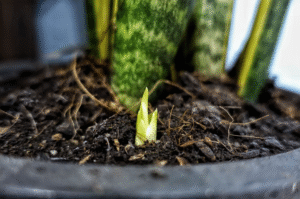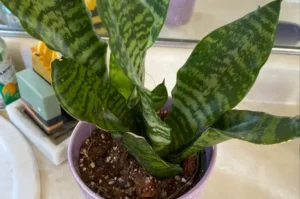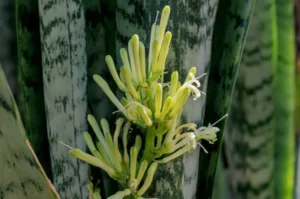Snake plants (Sansevieria), also known as mother-in-law’s tongue, are loved for their striking leaves and low-maintenance care. But did you know they can also flower? While rare, when a snake plant blooms, it surprises many plant lovers with its unique and fragrant flowers. In this article, we’ll explore what snake plant flowers look like, how they grow, and what makes them bloom.
How Often Do Snake Plants Flower?
Snake plant flowers are not an everyday sight. In fact, many people own snake plants for years without ever seeing one bloom. Flowering usually happens under specific conditions, often when the plant is slightly stressed, such as being root-bound. Snake plants that are healthy but slightly crowded in their pot are more likely to produce flowers. The flowering is not seasonal and can happen at any time of the year, although it’s more common in spring or early summer.
What Do Snake Plant Flowers Look Like?
Snake plant flowers grow on a long, slender stalk (called an inflorescence) that can reach up to 2-3 feet tall. The flowers themselves are small, tubular, and usually appear in clusters along this tall stem. Here are some specific features:
- Color: The flowers are usually creamy white, pale green, or light pink.
- Shape: They are narrow and tube-shaped, somewhat resembling honeysuckle or small lily blossoms.
- Texture: The petals are thin and delicate, often curling slightly at the tips.
- Fragrance: One of the most surprising features is their sweet, strong fragrance, especially at night. Many describe the scent as similar to jasmine or vanilla.
- Nectar: Snake plant flowers often secrete a sticky nectar that can attract insects or leave residue on nearby surfaces.
When and Why Do Snake Plants Flower?
Snake plants are more likely to flower under certain conditions:
1. Root-Bound Condition
When the roots have no more space to grow, the plant puts more energy into reproduction, leading to flowering.
2. Age of the Plant
Mature plants, usually several years old, are more likely to bloom than younger ones.
3. Proper Lighting
A snake plant kept in bright, indirect sunlight is more likely to flower than one in low light.
4. Mild Stress
Some stress, such as underwatering or being root-bound, can trigger the plant to produce flowers as a survival tactic.
5. Seasonal Triggers
Many snake plants that flower tend to do so in the spring or early summer, when light and temperature levels are ideal.
How Long Do Snake Plant Flowers Last?
The flower stalk may last for a few weeks. During this time, you’ll see the small flowers opening gradually along the stalk. After blooming, the flowers wither and dry up. The flower stalk does not regrow, and it’s best to cut it off once it’s dry to allow the plant to focus on leaf growth again.
Should You Be Concerned if Your Snake Plant Flowers?
Not at all! A flowering snake plant is generally a sign that the plant is mature and well cared for. However, if it is flowering due to stress, like being root-bound or under-watered, you might want to check its condition and consider repotting after the bloom is over.
Do All Snake Plant Varieties Flower?
Yes, all varieties of snake plants can potentially flower, but some types are more likely to do so. For example:
- Sansevieria trifasciata (the most common variety) often flowers in home settings.
- Sansevieria cylindrica can also flower, but less frequently.
- Sansevieria masoniana (whale fin) flowers occasionally but is more rare.
How to Encourage a Snake Plant to Bloom
If you’re eager to see your snake plant flower, here are a few tips:
- Keep it slightly root-bound – avoid repotting too frequently.
- Place it in bright, indirect light – near a sunny window is ideal.
- Water moderately – allow the soil to dry out between waterings.
- Avoid over-fertilizing – too much nitrogen can stop blooming.
- Be patient – sometimes, the plant needs a few years before it blooms.
Frequently Asked Questions (FAQs)
Are snake plant flowers toxic?
No, the flowers themselves are not toxic. However, the plant leaves are mildly toxic to pets and humans if ingested.
Can I pollinate snake plant flowers to get seeds?
Yes, but it’s difficult. You can try hand pollination using a small brush, but seed production is rare in home environments.
Should I cut the flower stalk?
Once the flowers are dry and finished blooming, you can cut the stalk at the base to keep the plant neat and encourage new leaf growth.
Is flowering harmful to the plant?
Not usually. However, flowering requires energy, so you may notice a slowdown in leaf growth during this time.
Can I propagate snake plants from flowers?
No, snake plants are best propagated from leaf cuttings or rhizome division. The flowers are part of reproduction, but seeds are hard to collect and grow.
Conclusion
Seeing your snake plant bloom is a rare and special experience. The flowers are beautiful, delicate, and fragrant, a reward for your patience and care. While not every snake plant will flower, creating the right conditions can increase the chances. So if you ever spot a tall stalk with tiny, white blossoms on your plant, enjoy the surprise, it’s nature’s way of saying you’re doing a great job!






